In this article, we will be talking about how to convert plain text to a musical notation PDF in Windows 10. You can create a piece of beautiful sheet music from the plain text on your Windows 11 or Windows 10 PC. For that, we are going to use a third-party application. Let us check out what is this third-party app and how you can use it to convert text to music notation PDF.
Convert Plain Text to Musical Notation PDF in Windows 11/10
To convert a plain text to music notes, we will be using a software called LilyPond. It is a free and open-source software using which you can create high-quality sheet music. It is quite different from other musical notation software like MuseScore that provides a GUI. You don’t get any graphical user interface in it to directly create musical notation. Instead, you need to create a file with music text and code and then convert it to a music notes’ PDF using this software.
Here are the basic steps to use LilyPond to create a musical notation PDF from plain text:
- Download and install LilyPond.
- Open Notepad.
- Type music code or text in predefined syntax.
- Save the text file with the .ly file extension.
- Double-click the LY file to create a PDF.
Let’s discuss these steps in detail!
Firstly, you need to have LilyPond installed on your PC. You can download this freeware from lilypond.org and then install it on your system.
Now comes the main task which is to write code for music notes. If you are an experienced musician, you might be knowing the musical syntaxes and codes. However, for beginners, it might be difficult. In any case, you don’t have to worry as LilyPond provides full documentation of music syntaxes and codes on its official website.
Simply open your Notepad application. Next, the first thing you need to enter is the version statement for LilyPond’s version you’re using. The latest version is 2.22.1, so write the below text in the Notepad:
\version "2.22.1"
After that, you need to enter text for musical notations. Suppose you want to print four simple notes, use the below code:
\version "2.22.1"
{
c' e' g' e'
}
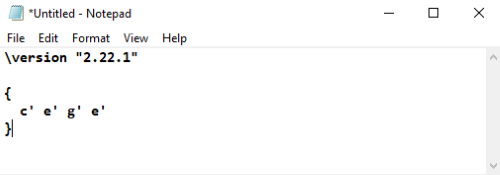
Similarly, if you want to print staff with musical notes suitable for a melodic fragment, you can use a similar code as below:
\version "2.22.1"
melody = \relative c' {
\clef treble
\key c \major
\time 4/4
a4 b c d
}
\score {
\new Staff \melody
\layout { }
\midi { }
}
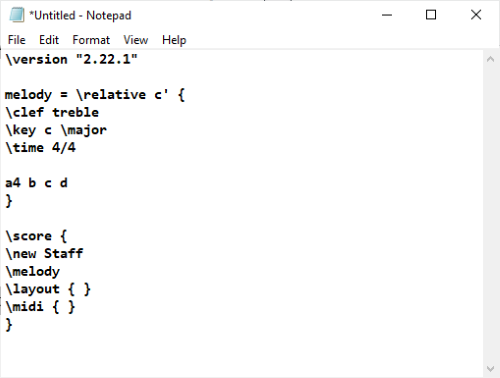
In case, you want to print notes along with lyrics, below is the musical notation syntax that you can use:
\version "2.22.1"
melody = \relative c' {
\clef treble
\key c \major
\time 4/4
a4 b c d
}
text = \lyricmode {
Your Lyrics
}
\score{
<<
\new Voice = "one" {
\autoBeamOff
\melody
}
\new Lyrics \lyricsto "one" \text
>>
\layout { }
\midi { }
}
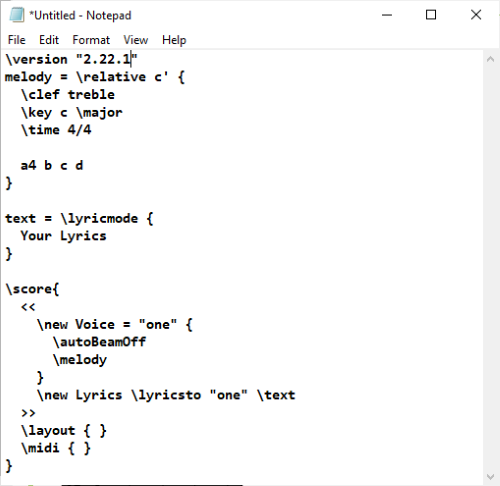
It provides various music notes templates and full documentation that you can access from here. Customize the templates and syntaxes as per your requirement and print desired sheet music.
After writing the music text, you need to save the text file with the .ly file extension. Simply go to the File menu and click the Save As option. Now, select Save as type to All Files and then put .ly extension after the filename and press the Save button. An LY file will be saved.

Now, double-click on the created LY file or right-click on it and tap on the Generate PDF option. As you do that, you will get the output PDF file in the same location as the input file.
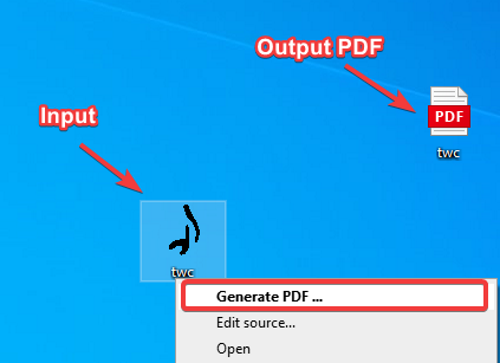
An example of musical notation created with LilyPond is shown in the below screenshot.
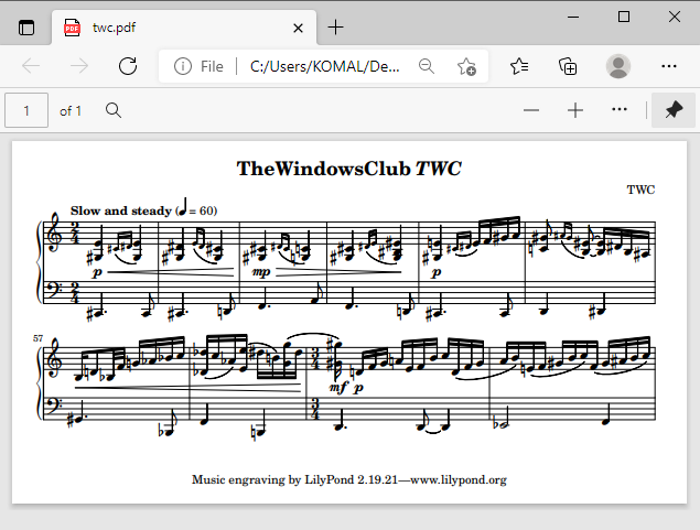
So, this is how you can create a high-quality PDF of musical notes from plain text in Windows 11/10.
Now read: How to insert Music Notes and Symbols in Microsoft Word.
Leave a Reply